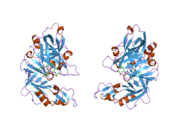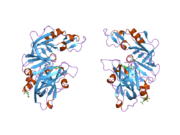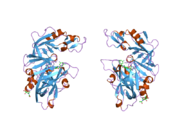Renin
Ensembl | |||||||||
|---|---|---|---|---|---|---|---|---|---|
| UniProt | |||||||||
| RefSeq (mRNA) | |||||||||
| RefSeq (protein) | |||||||||
| Location (UCSC) | Chr 1: 204.15 – 204.19 Mb | n/a | |||||||
| PubMed search | [2] | [3] | |||||||
| View/Edit Human | View/Edit Mouse |
| renin | |||||||||
|---|---|---|---|---|---|---|---|---|---|
| Identifiers | |||||||||
ExPASy | NiceZyme view | ||||||||
| KEGG | KEGG entry | ||||||||
| MetaCyc | metabolic pathway | ||||||||
| PRIAM | profile | ||||||||
| PDB structures | RCSB PDB PDBe PDBsum | ||||||||
| Gene Ontology | AmiGO / QuickGO | ||||||||
| |||||||||
Renin (
Renin is not commonly referred to as a
Biochemistry and physiology
Structure
The primary structure of renin precursor consists of 406 amino acids with a pre- and a pro-segment carrying 20 and 46 amino acids, respectively. Mature renin contains 340
Secretion
The enzyme renin is secreted by pericytes in the vicinity of the afferent arterioles and similar microvessels of the kidney from specialized cells of the juxtaglomerular apparatus—the juxtaglomerular cells, in response to three stimuli:
- A decrease in arterial blood pressure (that could be related to a decrease in blood volume) as detected by baroreceptors(pressure-sensitive cells). This is the most direct causal link between blood pressure and renin secretion (the other two methods operate via longer pathways).
- A decrease in sodium load delivered to the distal tubule. This load is measured by the macula densa of the juxtaglomerular apparatus.
- β1 adrenergic receptors.
Human renin is secreted by at least 2 cellular pathways: a constitutive pathway for the secretion of the precursor prorenin and a regulated pathway for the secretion of mature renin.[6]
Renin–angiotensin system

The renin enzyme circulates in the bloodstream and
Angiotensin I is further cleaved in the lungs by endothelial-bound
The normal concentration of renin in adult human plasma is 1.98–24.6 ng/L in the upright position.[10]
Function
Renin activates the
Renin is secreted from juxtaglomerular kidney cells, which sense changes in renal perfusion pressure, via stretch receptors in the vascular walls. The juxtaglomerular cells are also stimulated to release renin by signaling from the
Renin secretion is also stimulated by sympathetic nervous stimulation, mainly through β1 adrenoreceptor activation.[12]
The (pro)renin receptor to which renin and prorenin bind is encoded by the gene ATP6ap2, ATPase H(+)-transporting lysosomal accessory protein 2, which results in a fourfold increase in the conversion of angiotensinogen to angiotensin I over that shown by soluble renin as well as non-hydrolytic activation of prorenin via a conformational change in prorenin which exposes the catalytic site to angiotensinogen substrate. In addition, renin and prorenin binding results in phosphorylation of serine and tyrosine residues of ATP6AP2.[13]
The level of renin mRNA appears to be modulated by the binding of
Genetics
The
Mutations in the REN gene can be inherited, and are a cause of a rare inherited kidney disease, so far found to be present in only 2 families. This disease is autosomal dominant, meaning that it is characterized by a 50% chance of inheritance and is a slowly progressive chronic kidney disease that leads to the need for dialysis or kidney transplantation. Many—but not all—patients and families with this disease have an elevation in serum potassium and unexplained anemia relatively early in life. Patients with a mutation in this gene can have a variable rate of loss of kidney function, with some individuals going on dialysis in their 40s while others may not go on dialysis until into their 70s. This is a rare inherited kidney disease that exists in less than 1% of people with kidney disease.[16]
Clinical applications
An over-active renin-angiotensin system leads to vasoconstriction and retention of
In current medical practice, the renin–angiotensin–aldosterone system's overactivity (and resultant hypertension) is more commonly reduced using either ACE inhibitors (such as ramipril and perindopril) or angiotensin II receptor blockers (ARBs, such as losartan, irbesartan or candesartan) rather than a direct oral renin inhibitor. ACE inhibitors or ARBs are also part of the standard treatment after a heart attack.
The
Measurement
Renin is usually measured as the plasma renin activity (PRA). PRA is measured specially in case of certain diseases that present with hypertension or hypotension. PRA is also raised in certain tumors.[20] A PRA measurement may be compared to a plasma aldosterone concentration (PAC) as a PAC/PRA ratio.
Discovery and naming
The name renin =
See also
- Angiotensin-converting enzyme
- Plasma renin activity
- Renin inhibitor
- Renin stability regulatory element (REN-SRE)
References
- ^ a b c GRCh38: Ensembl release 89: ENSG00000143839 – Ensembl, May 2017
- ^ "Human PubMed Reference:". National Center for Biotechnology Information, U.S. National Library of Medicine.
- ^ "Mouse PubMed Reference:". National Center for Biotechnology Information, U.S. National Library of Medicine.
- PMID 21087212.
- PMID 6324167.
- PMID 2893797.[permanent dead link]
- ISBN 978-1-4160-2328-9.
- PMID 15372104.
- ^ Brenner & Rector's The Kidney, 7th ed., Saunders, 2004, pp. 2118-2119 Full Text with MDConsult subscription Archived 2015-02-07 at the Wayback Machine
- ^ "Laboratory Reference Centre Manual". Hamilton Regional Laboratory Medicine Program.[permanent dead link]
- PMID 22814999.
- S2CID 25873845.
- PMID 12045255.
- PMID 12933794.
- PMID 6089171.
- PMID 19664745.
- ^ Presentation on Direct Renin Inhibitors as Antihypertensive Drugs Archived 2010-12-07 at the Wayback Machine
- PMID 19715410.
- S2CID 38702564.
- ^ Hamilton Regional Laboratory Medicine Program - Laboratory Reference Centre Manual. Renin Direct.
- S2CID 22118033.
- .
Further reading
- Stefanska A, Kenyon C, Christian HC, Buckley C, Shaw I, Mullins JJ, Péault B (December 2016). "Human kidney pericytes produce renin". Kidney International. 90 (6): 1251–1261. PMID 27678158.
- Kmoch S, Živná M, Bleyer AJ (2015). "Familial Juvenile Hyperuricemic Nephropathy Type 2". In Adam MP, Everman DB, Mirzaa GM, Pagon RA, Wallace SE, Bean LJ, Gripp KW, Amemiya A (eds.). GeneReviews [Internet]. Seattle (WA): University of Washington, Seattle. pp. 1993–2014. PMID 21473025.
External links
- The MEROPS online database for peptidases and their inhibitors: A01.007[permanent dead link]
- Renin at the U.S. National Library of Medicine Medical Subject Headings (MeSH)
- Overview of all the structural information available in the PDB for UniProt: P00797 (Renin) at the PDBe-KB.
























